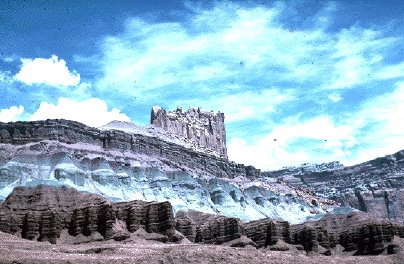
The Queen's Throne - Utah
- Microsoft Word if you use that Word Processor or
- A Netscape Document that you can print (use the Left Arrow key to return to this page).
- Or, you may view the Sedimentary Rocks power point presentation shown in class.
You may wish to print a copy of the lecture outline (minus the illustrations) and you have two options:
Course Objectives
-
After reading Chapter Six, you should be able to:
- List and describe the types of detrital sedimentary rocks.
- List and describe the types of chemical sedimentary rocks.
- Describe the abundance of different types of sedimentary rocks
- Explain how a sediment becomes a sedimentary rock.
- Describe the types of environments where sedimentary rocks are formed.
- Describe sedimentary structures.
- Explain the significance of fossils in sedimentary rocks.
Introduction
-
Think of the following three S's when you think about sedimentary rocks.
For every sedimentary rock there is a source area. The composition of the source area, the climate, and the geologic setting influence how the source material will respond as it is exposed to the Earth's reactive atmosphere. Processes (wind, water, ice) may serve to move the weathered debris (sediment) down slope until the sediment is deposited in some environment of accumulation or sink. By studying sedimentary rocks the geologist attempts to reconstruct the conditions under which the sediment was produced, transported and eventually deposited.
Class Notes
Internet Resources
- An Introduction to Sedimentary Rocks
"Sedimentary rocks are those rocks which form at or near the earth's surface at relatively low temperatures and pressures primarily by either:
-
1.deposition by water, wind or ice
2.precipitation from solution (may be biologically mediated); and /or
3.growth in position by organic processes (e.g., carbonate reefs ) - Petrography of Sedimentary Rocks
"Sedimentary rocks cover some 80% of the Earth's crust. All our knowledge of stratigraphy, and the bulk of our knowledge of structural geology, are based on studies of sedimentary rocks." [pages 1-6]
- Plate Tectonics and the Rock Cycle
"James Hutton (1727 - 1797), the eminent 18th century gentleman farmer and founder of modern geoscience, authored the concept of the rock cycle, which depicts the interrelationships between igneous, sedimentary, and metamorphic rocks. The upper part of the earth (mantle, crust and surface) can be envisioned as a giant recycling machine; matter that makes up rocks is neither created nor destroyed, but is redistributed and transformed from one rock type to another. PETROLOGY, the study of rocks and their origins, is essentially the formal process by which we resolve the interrelationships expressed in the rock cycle."
A Virtual Field Trip to the Grand Canyon
-
The Grand Canyon is a classic locality to study layer cake geology"
How was it formed? ...... "The truth is that no one knows for sure though there are some pretty good guesses. The chances are that a number of processes combined to create the views that you see in todays Grand Canyon. The most powerful force to have an impact on the Grand Canyon is erosion, primarily by water (and ice) and second by wind. Other forces that contributed to the Canyon's formation are the course of the Colorado River itself, vulcanism, continental drift and slight variations in the earths orbit which in turn causes variations in seasons and climate."
Learning about geology from a computer screen is only half as fun as enjoying it in the field!
Self-Quiz
| jbutler@uh.edu
|E-mail the ClassListserv|Read the ClassListserv|
|Textbook Home Page
|Glossary of Geologic Terms|Search These Pages|
|Other Courses|Resources|Grade Book|
Copyright by John C. Butler, July 29, 1995